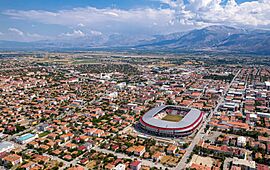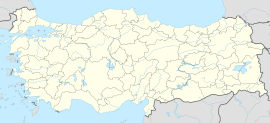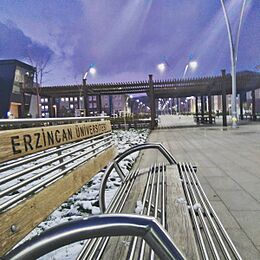Erzincan facts for kids
|
Erzincan
|
|
|---|---|
Quick facts for kids
|
|

View of Erzincan
|
|
| Country | Turkey |
| Province | Erzincan |
| District | Erzincan |
| Population
(2022)
|
150,714 |
| Time zone | TRT (UTC+3) |
Erzincan (pronounced [æɾˈzindʒan]) is an important city in eastern Turkey. It is the capital of Erzincan Province. The city is surrounded by other cities like Erzurum, Sivas, and Malatya. Most people in Erzincan are Sunni Turks, but there is also a group of Alevi Kurdish people.
In 2022, about 150,714 people lived in Erzincan. This number has grown quite a bit from 86,779 people in 2007.
Contents
History of Erzincan
Ancient Times
The area where Erzincan is today was once called Acilisene. In the year 387 AD, a peace agreement called the Peace of Acilisene was signed here. This agreement divided Armenia into two parts. One part was controlled by the Byzantine Empire, and the other by Persia.
Long ago, the city was known as Erez. For a while, it was even called Justinianopolis to honor Emperor Justinian.
Early Beliefs and Christianity
In the ancient settlement of Erez, there was a special place of worship for the Armenian goddess Anahit. A historical text tells us that King Trdat of Armenia visited this temple. He asked Gregory the Illuminator, who was secretly a Christian, to make an offering there. When Gregory refused, he was captured and tortured. This event eventually led to King Trdat becoming Christian about 14 years later.
After Armenia became Christian, the temple at Erez was destroyed. Its lands were given to Gregory. The area later became known for its many monasteries.
Medieval Period
In 1071, Erzincan became part of the Mengüçoğlu kingdom, which was under the Seljuk rule. The famous traveler Marco Polo visited Erzincan and wrote about it. He said that the "people of the country are Armenians" and called Erzincan the "noblest of cities."
In 1243, the city was destroyed during a battle between the Seljuks and the Mongols. However, by 1254, the city had recovered. William of Rubruck wrote that an earthquake killed over 10,000 people there. During this time, Erzincan was somewhat independent, ruled by Armenian princes.
Erzincan was also very important in the history of the Safavid dynasty. In the summer of 1500, about 7,000 warriors gathered here. They came to support Ismail I in starting his new kingdom.
Ottoman Era
When Erzincan became part of the Ottoman Empire, it grew a lot in size and population. Records from the 1500s show that the city had many neighborhoods, some for Muslims and some for Christians. The famous traveler Evliya Çelebi visited in 1647. He wrote that the city had a castle and many houses, mosques, and bathhouses.
Later, in the late 1800s, records show that Erzincan had a mixed population. Most people were Muslims, but there were also many Armenians and some Greeks.
Battle of Erzincan
The Battle of Erzincan happened during World War I. In 1916, Erzincan was the main base for the Turkish Third Army. The Russian General Nikolai Yudenich led the Russian army. They captured nearby towns and then advanced on Erzincan. The city was taken by the Russians on July 25, 1916. The city itself was not badly damaged, and the Russians found many supplies.
Erzincan Soviet
For a short time between 1916 and 1918, Erzincan had a special council called the Erzincan Soviet. This happened when Russian soldiers took control after the revolution. They invited Kurdish, Turkish, and Armenian representatives to help run the city.
Seizure of Erzincan
| Seizure of Erzincan | |||||||
|---|---|---|---|---|---|---|---|
|
|||||||
| Belligerents | |||||||
|
|||||||
| Commanders and leaders | |||||||
After the Russian army left, the Ottoman forces, led by Kâzım Karabekir, took back control of Erzincan on February 13, 1918. This day is still celebrated in the city. Armenian soldiers left Erzincan and headed towards Erzurum. They faced attacks from Kurdish groups during harsh snowstorms.
Turkish Republic
1939 Erzincan Earthquake
On December 27, 1939, a very strong earthquake completely destroyed Erzincan. There were seven powerful shocks, with the biggest one measuring 7.8. This was one of the strongest earthquakes ever recorded in Turkey. The first part of the earthquake killed about 8,000 people. The total number of deaths reached over 32,000 due to more earthquakes and floods.
The damage to Erzincan was so bad that the old city site was left empty. A new town was built a little further north.
Demographics
In the 13th century, Marco Polo wrote that most people in Erzincan were Armenian. By 1830, the Armenian population grew to 15,000. In the 1890s, records show that Erzincan had about 23,000 people. This included 15,000 Muslims and 7,500 Armenians, along with some Greeks and others.
Before World War I, about 13,109 Armenians lived in Erzincan. During the war, many Armenians and Greeks living in Erzincan were forced to leave their homes.
Climate
Erzincan has a continental climate. This means it has cold, snowy winters and hot, dry summers. Spring is usually the wettest time of year, while summer is the driest.
The coldest temperature ever recorded in Erzincan was -31.2°C (-24.2°F) on January 15, 1950. The hottest temperature was 40.6°C (105.1°F) on July 30, 2000. The most snow recorded was 74 cm (29.1 inches) in February 1950.
| Climate data for Erzincan (1991–2020, extremes 1929–2022) | |||||||||||||
|---|---|---|---|---|---|---|---|---|---|---|---|---|---|
| Month | Jan | Feb | Mar | Apr | May | Jun | Jul | Aug | Sep | Oct | Nov | Dec | Year |
| Record high °C (°F) | 14.6 (58.3) |
17.2 (63.0) |
25.2 (77.4) |
30.0 (86.0) |
33.8 (92.8) |
37.0 (98.6) |
40.6 (105.1) |
40.5 (104.9) |
37.2 (99.0) |
31.4 (88.5) |
24.9 (76.8) |
19.0 (66.2) |
40.6 (105.1) |
| Mean daily maximum °C (°F) | 2.8 (37.0) |
4.8 (40.6) |
10.9 (51.6) |
17.3 (63.1) |
22.7 (72.9) |
27.9 (82.2) |
32.4 (90.3) |
33.0 (91.4) |
28.1 (82.6) |
20.7 (69.3) |
12.0 (53.6) |
5.1 (41.2) |
18.1 (64.6) |
| Daily mean °C (°F) | −1.9 (28.6) |
−0.3 (31.5) |
5.3 (41.5) |
11.0 (51.8) |
15.7 (60.3) |
20.5 (68.9) |
24.3 (75.7) |
24.5 (76.1) |
19.6 (67.3) |
13.2 (55.8) |
5.7 (42.3) |
0.5 (32.9) |
11.5 (52.7) |
| Mean daily minimum °C (°F) | −5.7 (21.7) |
−4.3 (24.3) |
0.5 (32.9) |
5.5 (41.9) |
9.5 (49.1) |
13.4 (56.1) |
16.7 (62.1) |
16.8 (62.2) |
12.0 (53.6) |
7.0 (44.6) |
0.9 (33.6) |
−3.1 (26.4) |
5.8 (42.4) |
| Record low °C (°F) | −31.2 (−24.2) |
−30.2 (−22.4) |
−22.4 (−8.3) |
−11.1 (12.0) |
−4.2 (24.4) |
2.0 (35.6) |
5.0 (41.0) |
5.9 (42.6) |
0.3 (32.5) |
−6.8 (19.8) |
−15.6 (3.9) |
−25.9 (−14.6) |
−31.2 (−24.2) |
| Average precipitation mm (inches) | 26.3 (1.04) |
29.7 (1.17) |
45.5 (1.79) |
54.2 (2.13) |
57.2 (2.25) |
25.2 (0.99) |
14.1 (0.56) |
6.6 (0.26) |
17.5 (0.69) |
41.9 (1.65) |
36.2 (1.43) |
25.7 (1.01) |
380.1 (14.96) |
| Average precipitation days | 8.77 | 9.17 | 11.63 | 13.67 | 14.77 | 8.83 | 3.67 | 2.93 | 4.53 | 8.87 | 8 | 9.37 | 104.2 |
| Average relative humidity (%) | 72 | 68.9 | 61.5 | 57.1 | 57 | 50.8 | 46.3 | 46 | 49.2 | 62 | 67.8 | 72.5 | 59.3 |
| Mean monthly sunshine hours | 93.0 | 121.5 | 145.7 | 168.0 | 210.8 | 264.0 | 294.5 | 275.9 | 231.0 | 189.1 | 129.0 | 89.9 | 2,212.4 |
| Mean daily sunshine hours | 3.0 | 4.3 | 4.7 | 5.6 | 6.8 | 8.8 | 9.5 | 8.9 | 7.7 | 6.1 | 4.3 | 2.9 | 6.1 |
| Source 1: Turkish State Meteorological Service | |||||||||||||
| Source 2: NOAA(humidity) | |||||||||||||
Neighborhoods
Erzincan is made up of many different neighborhoods. Some of these include Akşemsettin, Aktoprak, Akyazı, Aslancak, Arslanlı, Atatürk, Aziz Baba, Bahçelievler, Barbaros, Barış, Başbağlar, Başpınar, Bayrak, Bozyazı, Buğdaylı, Bulutlu, Büyük Çakırman, Cemal Gürsel, Cumhuriyet, Çarşı, Çukurkuyu, Davarlı, Demetevler, Demirkent, Dereyurt, Ergenekon, Ersevenler, Ertuğrul Gazi, Esentepe, Fatih, Gazi, Gölcük, Gülalibey, Güllüce, H.Ahmet Yesevi, Halitpaşa, Hamidiye, Hancı, Hocabey, Hürrempalangası, Işıkpınar, İnönu, İzzetpaşa, Karaağaç, Kavakyolu, Kazımkarabekir, Keklikkayası, Kızılay, Kurutilek, Menderes, Mengüceli, Mimarsinan, Munzur, Mustafa Kemal Paşa, Osman Gazi, Osmanlı, Özgürlük, Paşa, Sancak, Sarıgöl, Selçuklu, Şehit Cengiz Topel, Şehit Serhat, Şehit Serhat Yurtbaşı, Taksim, Terzibaba, Ulalar, Üçkonak, Yalnızbağ, Yavuzselim, Yeni, Yenidoğan and Yunusemre.
Economy
In the early 1900s, Erzincan had many mulberry tree farms. These trees were used for sericulture, which is the raising of silkworms to produce silk.
Notable People
- See Category:People from Erzincan
Mayors of Erzincan
- 1977–1980 and 1984–1989 Adnan Ercan (MHP, ANAP)
- 1989–1999 Talip Kaban (MÇP, MHP)
- 1999–2004 Erkan Karaman (MHP)
- 2004–2009 Mehmet Buyruk (AK Party)
- 2009–2014 Yüksel Çakır (AK Party)
- 2014–2019 Cemalettin Başsoy (AK Party)
- 2019–present Bekir Aksun (MHP)
See also
 In Spanish: Erzincan para niños
In Spanish: Erzincan para niños




